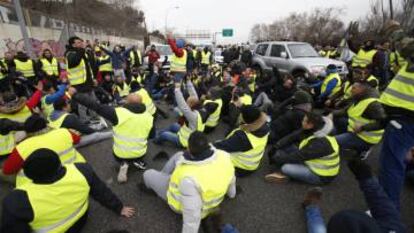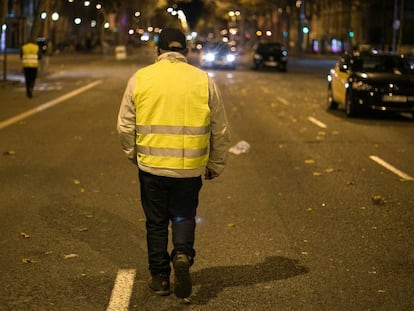Why has traffic in Madrid improved with the taxi strike?
Each cab travels around 200 kilometers a day, but most of the time, they¡¯re driving around empty looking for passengers

People who drive regularly in the city of Madrid have a sensation these past weeks that the taxi strike that began on January 21 is actually having a positive effect on traffic.
Statistics offered by the city of Madrid appear to support this feeling. Compared with the same period in 2018, traffic was less intense on the three days that Madrid hosted the tourism fair Fitur last week. Traffic intensity during rush hour was a bit lower, and markedly so during off-peak times.
We need to reconsider the role of taxis in the city, and how it is possible that a stoppage has had such a huge impact on the city¡¯s mobility
Adri¨¢n Fern¨¢ndez, Greenpeace
The same thing happened on Monday, January 28 of this year compared with the same day in 2018 (both days had similar weather and no major events going on).
Around one million vehicles enter Madrid each day. So why does traffic improve if there are fewer than 15,700 licensed taxicabs in the city?
¡°A private driver on a daily commute covers an average of around 12 kilometers each way. But a taxi driver covers around 200 kilometers on any given working day,¡± says David Lois, a professor at the distance university UNED and a researcher at the Transportation Research Center at Madrid¡¯s Polytechnic University.
¡°We are used to that level of traffic; even if there are not that many [taxis], they are constantly driving around ¨C that¡¯s why you notice it so much when they¡¯re not there,¡± adds Lois.

According to a report on taxi services drafted by Madrid authorities, there are 20,067 taxi drivers in the city (27% of them work for the owners of the taxi licenses.) They cover 208 kilometers per shift, although the vehicles are empty for 54.6% of that distance.
The report also finds that 44% of taxi drivers do not use taxi stops, instead preferring to cruise the streets in search of clients. And 60% of taxi drivers do not use any kind of application to connect with passengers. The study is based on a 2017 survey of 400 drivers and 800 customers.
There is nothing to indicate that drivers of vehicles with VTC licenses ¨C which ride-booking services such as Uber and Cabify use ¨C behave any differently from taxi drivers. Even though these services are hired via a smartphone app, drivers tend to cruise around in areas where they expect to find more customers.
Emptier streets
Madrid authorities publish several indicators to measure traffic levels in the city. A detailed analysis of the hourly traffic intensity at measurement stations around the city shows which areas had fewer vehicles on the streets during Fitur, compared with the same week a year ago.
From Wednesday to Saturday, throughout the city, between 10am and 5pm, there was an average drop of 11%, which means that at every measurement station, there were up to 80 fewer vehicles per hour than on a normal day. But in Barcelona, traffic actually increased during the taxi strike there, according to public data released by city officials.
Taxis are constantly going around, that¡¯s why you notice it so much when they¡¯re not there
David Lois, researcher
Adri¨¢n Fern¨¢ndez, the spokesman for mobility issues at Greenpeace, says that ¡°Barcelona¡¯s road network is less complex, traffic is concentrated on Gran V¨ªa, the ring roads and the Diagonal. Madrid has lots of highways and roads and it¡¯s not that easy.¡±
In Madrid, traffic was noticeably smoother on major avenues that are normally clogged up, such as Alcal¨¢ street or the Castellana boulevard. And in Madrid Central, the downtown section that is now closed off to non-resident vehicles (but not to taxis), the drop has been even sharper, with 20% fewer vehicles per hour.
Public transportation
Meanwhile, city buses and subway lines have reached new passenger records. The Feria de Madrid Metro stop, which is closest to the site of the Fitur trade exhibition, registered 141,242 commuters from Wednesday to Friday, representing nearly a 60% rise from Fitur 2018. ¡°The strike has changed the habits of many people who always take taxis, and who have discovered that there¡¯s something called the Metro that actually works really well,¡± says Lois.
The EMT, which operates the bus lines, said that trips grew by 1.56% to nearly 1.6 million passengers a day. ¡°Keep in mind that the partial closure of the subway¡¯s Line 2 and the drop in private vehicles due to Madrid Central also play a role,¡± said a spokeswoman for Madrid¡¯s mobility and environment department.
Taxi drivers affected
Adri¨¢n Fern¨¢ndez, of Greenpeace, thinks the existing model is unsustainable. ¡°The first people to be adversely affected are the taxi drivers, who have to spend hours wasting fuel driving around in an empty car,¡± he says. ¡°To improve efficiency, there are two historical demands: increasing the number of taxi stops, and creating a single mobile app that all taxi drivers could use.¡±
¡°We need to reconsider the role of taxis in the city, and how it is possible that a stoppage has had such a huge impact on the city¡¯s mobility,¡± he adds.
Fern¨¢ndez thinks that empty taxis should not be allowed into Madrid Central, unless a client has booked their services. ¡°This is the 21st century; ideally most taxis should be available through apps or a phone call, or at taxi stops. Having them drive around empty is not efficient.¡±
David Lois thinks authorities should regulate the amount of time that taxis can drive around town ¡°because that would reduce traffic jams. ¡°Now that the debate is on the agenda, it would be a good time to legislate.¡±
English version by Susana Urra.
Tu suscripci¨®n se est¨¢ usando en otro dispositivo
?Quieres a?adir otro usuario a tu suscripci¨®n?
Si contin¨²as leyendo en este dispositivo, no se podr¨¢ leer en el otro.
FlechaTu suscripci¨®n se est¨¢ usando en otro dispositivo y solo puedes acceder a EL PA?S desde un dispositivo a la vez.
Si quieres compartir tu cuenta, cambia tu suscripci¨®n a la modalidad Premium, as¨ª podr¨¢s a?adir otro usuario. Cada uno acceder¨¢ con su propia cuenta de email, lo que os permitir¨¢ personalizar vuestra experiencia en EL PA?S.
?Tienes una suscripci¨®n de empresa? Accede aqu¨ª para contratar m¨¢s cuentas.
En el caso de no saber qui¨¦n est¨¢ usando tu cuenta, te recomendamos cambiar tu contrase?a aqu¨ª.
Si decides continuar compartiendo tu cuenta, este mensaje se mostrar¨¢ en tu dispositivo y en el de la otra persona que est¨¢ usando tu cuenta de forma indefinida, afectando a tu experiencia de lectura. Puedes consultar aqu¨ª los t¨¦rminos y condiciones de la suscripci¨®n digital.










































